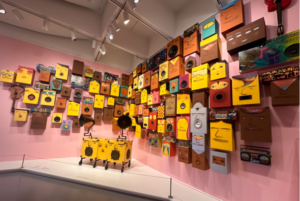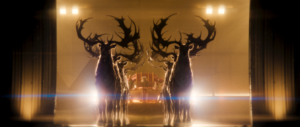Spooky Presents: The Collaborators
In the quest for the purpose of art, one does not expect Josef Stalin himself as the obstacle to achievement.
Spooky Action Theater Company’s production of The Collaborators by British playwright John Hodge speaks to the protection of principle in art, and the mangling of that protection when one encounters a nearly insurmountable obstacle.
During the 1930s Josef Stalin enacted a series of purges of the members of his political establishment in a time known afterwards as his Great Terror. The playwright Mikhail Bulgakov wrote plays during this period, as other artists struggled to produce their mode of art in these tense conditions. It is the production of art that concerns the play, and the attempt to produce art under such fraught circumstances as a relationship between the dictator of the Soviet Union, Josef Stalin, and a politically outspoken playwright, like Mikhail Bulgakov, would create.
Bulgakov, played with fervor by Paul Reisman, starts the play in a dream. He is chased by Stalin, who wields a typewriter. In his dream, both the tools of Bulgakov’s art and the figure of his horror join together to attack him. It is a theme the play revisits throughout.
Joe Duquette plays Stalin as a John Wayne-esque figure of male confidence, with a fatherly demeanor that draws you in, a person of friendly danger. Out of all the characters in the play, Duquette’s comes across most intensely. It is with a strong presence that he is able to embody the nuanced contradictions of Stalin’s external nature and the turmoil of his interior mind.
Playing off the performance of the uncomfortably present dictator is Yelena, Bulgakov’s wife, performed with an emotional grounding by Mackenzie Beyer. She is the Sam to Bulgakov’s Frodo, giving him counsel. By the events of the play, Bulgakov comes to a greater loss of control over the purpose of his art, his struggles in pursuit of morality against oppression dwindle in the face of Stalin’s masterful manipulation.
Tasked with writing a play on the life of Stalin, Bulgakov objects on the grounds that his art serves to protest the man’s oppressive regime. However, over time, Bulgakov’s resolve is not so much worn down as manipulated. It is this unwitting manipulation that draws the characters of the play to comment. Does Bulgakov not really realize the extent to which he is being used?
The play moves at a speedy pace. Scenes flash by with a film-like consistency, telling the story and moving on without lingering. It makes the few silent moments of the play stand out; the audience holds their breath, and then the action continues. Performed with two risers surrounding an angled aisle, the audience feels uncomfortably in the middle of the action. Exits abound, and stationary props are placed throughout the performance space. Red lines cut across the stage at an angle, which according to the set designer, Giorgos Tsappas, are inspired by German Expressionism and Wassily Kandinsky, forces in the contemporary Soviet milieu. These lines, expressive in their violent and bloody meaning, sprang from the set with force during the tension-filled second act.
A disturbingly comic look at the difficulty of the artistic pursuit, The Collaborators provides a medium of discussion through the mouths of characters, even ones as seemingly disparate as Josef Stalin and Mikhail Bulgakov.






